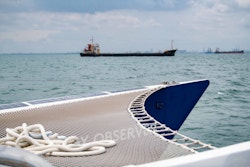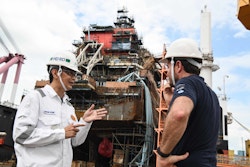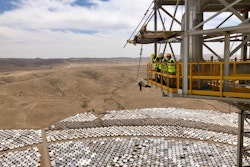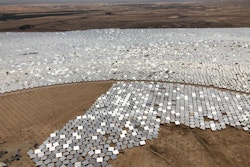Singapore: energy challenges of a city-state
Beatrice Cordiano, our energy and sustainability expert, gives us an overview of the energy landscape in Singapore, our main stopover in Asia. Provided that its energy mix relies almost entirely on fossil fuels today, the challenges to reach carbon neutrality are huge.

Energy Observer in Singapore
About 85 miles north of the Equator, at the southernmost point of the Malay Peninsula, lays Singapore. Historically inhabited by fishermen, Singapore (Singapura originally, “Lion City”) originally served as an outpost for the Sumatran empire of Srivijava. It entered an era of prosperity as one of the biggest naval bases later, thanks to the demand of rubber and tin from the West, under the British Empire and after the construction of the Suez Canal in 1869.
Separated from Malaysia by the Johor Strait and from Indonesia by the Singapore Strait, this 63-island city-state has today the largest port in Southeast Asia and one of the busiest worldwide in terms of shipping tonnage. It owes its popularity to its strategic position on the Strait of Malacca, a major sea route connecting the Indian Ocean and the South China Sea.
Singapore: a major shipping hub with no natural resources
Since 1960, Singapore has been experiencing an economic growth and diversification which made it gain the role of world trade centre, ranking 3rd among the largest foreign exchange hubs, and become one of the Four Asian Tigers, along with Hong Kong, South Korea and Taiwan. Although its economy is one of the most advanced in Southeast Asia, there is one difference with the other countries: Singapore has no big natural resources and thus it has never been primarily dependent on the production and export of its own commodities. For this reason, it has always pursued a policy of export-oriented industrialisation, shipping raw materials in exchange for finished goods. This is the case with oil, which has always been imported in its crude form and exported as refined petroleum, representing around 15% of Singapore’s export value.

Singapore's exports, 2019
Decarbonising energy: still a long way to go
How energy is produced is becoming increasingly important as countries try to get rid of fossil fuels and integrate more low-carbon energy sources. As many other city-states worldwide, Singapore has some challenges to face: the main problem lays in its small dimensions and island nature to which adds up a skyrocketing economy, that makes it hard for it to energetically keep up in a sustainable way.
With a primary energy demand of 986 TWh in 2019 - 3,6 times higher than in 1990 - its energy mix remains fossil-based up to 99,76%. The country has no hydrocarbon resources and gets enormous quantities of crude oil from Qatar, Saudi Arabia and Kuwait, which -if not exported- it refines for its own purpose. It is indeed easier to import fossil fuels rather than clean energy, especially if you are the 3rd biggest oil-refining and trading centre in the world.
Oil is indeed a major player in the primary energy mix, covering a good 86% share of it.

Arrival in Jakarta
Natural gas, the transition fuel?
Electricity has become a vital part of the modern development, bringing so many conveniences in our daily lives: from having light at night, to cooking, doing the laundry or connecting people around the world. It is impossible to imagine our lives without it. It can be produced in many different ways but when it comes to Singapore, natural gas is the winner. Nearly 95% of power generation comes from this gas, imported through pipes from its neighbours or in liquefied form from around the world.

Electricity mix of Singapore
Many people state natural gas is the “fuel of the future”. To some extent it is true: gas is available, energy from it can be tapped on demand, it emits less than other fossil fuels when burnt. Yet it is impossible to forget that despite these great advantages, it is not a renewable source, it still emits greenhouse gases, not only during its use but also during its extraction and production. Also, natural gas is mainly methane, and methane is one of the most impacting gases in terms of global warming: when it slips into the atmosphere it survives less than CO2 but it is up to 36 times more powerful.
Transition is everything but easy. It takes a lot of effort to do it and it takes precious time which we are running out of. It is thus essential not only to develop low and zero-carbon solutions but also to deploy them at large scale to be able to concretely decrease emissions on the long run.
Solar versus available space
Being so gas-based, Singapore’s power sector accounts for 40% of the country’s carbon emissions and decarbonising it is key to the climate change effort. Nevertheless, the desire to shift towards renewable energies to reduce the carbon footprint needs to face geographic limitations. Most renewable options other than solar are not exploitable: there is too little wind for turbines and no major rivers for hydro, and the country is forced to tap these sources where they are available, importing low-carbon energy from overseas. The lack of clean resources is not the only obstacle, space is too.
The country is the 3rd most densely populated in the world, every corner is covered in buildings and large renewable power plants are difficult to be installed. As a consequence, rooftop and floating solar photovoltaic systems are the only reliable and cost-effective renewable option on the territory to reduce the dependence on fossil fuels and face land constraints. The country has ramped up solar PV deployment on rooftops and walls and, on its never-ending quest for available space, it started betting on water surfaces as space-saving solutions, building one of the world’s largest floating solar farms on the Tengeh Reservoir.
With 443,5 MWp installed at the end of 2021, Singapore is one of the most solar dense cities in the world.
The energy security dilemma
Singapore has issued strong energy policies: it aims at peaking emissions by 2030 to reach carbon neutrality in the second part of the century and it will do it by improving energy efficiency by 36% from 2005 levels and increasing solar capacity to 2 GWp. Solar won’t certainly be sufficient to meet all electricity demand, in fact it could cover just about 4% of it. For this reason, the country decided to import clean electricity from abroad to meet 30% of its needs by 2035. This is quite a good plan for a city-state with such ambitious goals but unfortunately, this objective has already hit a snag when Malaysia banned renewables sales last year to prioritize its own decarbonisation.
Energy insecurity and dependence make a transition challenging: importing electricity may not be easy, especially if it needs to be low-carbon. It may also not be cheap: generation costs might be lower but transmission, backup and grid enhancements costs could get higher.
Lowering fossil fuels consumption is not enough to tackle global warming, we must green the energy mix, adding more renewables and developing and improving the way we store energy. Sometimes - and that is the case - this is neither immediate nor trivial and decarbonisation pathways need to be rethought.

Victorien Erussard visting SembCorp Marine, Singapore
Rethinking decarbonisation : the blue hydrogen roadmap
Hydrogen is an incredibly versatile element and it can be produced in many different, more or less polluting, ways: from fossil fuels - natural gas especially - or water.
Overturning the energy portfolio and producing green hydrogen at scale using domestic renewable electricity will be challenging in an extremely built-up, small country like Singapore. Nevertheless, that doesn’t seem to stop the city’s race to reach net-zero.
Here, hydrogen could be extracted from natural gas in large quantities, and the carbon dioxide resulting from the process could be trapped by Carbon Capture Utilisation and Storage (CCUS) technologies and then either injected and permanently stored in underground cavities or used as a feedstock to produce - among other things - alternative fuels.

Depiction of grey, blue and green hydrogen production
Sometimes it is necessary to adapt the solutions based on the available resources and here, coupling hydrogen production and advanced low-carbon technologies can definitely represent a long-term option to diversify the country’s fuel mix and reduce the carbon emissions related to power generation, industrial processes and heavy transportation.
In terms of global climate, it does not actually matter where emissions abatement takes place. Nevertheless, in a world where everyone competes upon their green credentials, places like Singapore - whose transition inevitably depends on others - can be incredibly disadvantaged. Therefore, finding innovative approaches based on local strengths is essential to start decarbonising our economies, starting as soon as possible while the ultimate solutions reach scale and become affordable.
To go further:
- Singapore plans to import 30% of energy from low-carbon sources by 2035 - Straitstimes.com
- Singapore's Energy Dilemma a Small-Nation Warning - Bloomberg.com
- Hope for green future also rests on harnessing hydrogen, trapping carbon dioxide - Straitstimes.com

